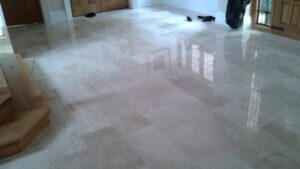In New Malden, this limestone floor had lost its finish. The surface had become dull, scratched, and stained and years of foot traffic and poor cleaning had taken a toll. The homeowners reached out to Fabritec Tile Cleaning for help. They wanted their floor restored to its former beauty. This case study details how Fabritec expertly cleaned, honed, and sealed the limestone, bringing it back to life.
Understanding Limestone
Limestone is a sedimentary rock, prized for its beauty and durability. However, it is porous. This porosity makes it prone to absorbing dirt, liquids, and stains. Limestone's soft surface also makes it susceptible to scratching and etching. Over time, if not correctly cared for, limestone floors will lose their natural beauty. In this case, the homeowners used common household cleaners, often containing strong acid or alkali ingredients. These cleaners had stripped away the protective seal and damaged the stone.
 Why Limestone Requires Professional Care
Why Limestone Requires Professional Care
Many homeowners are unaware of how delicate limestone can be. Standard cleaning solutions can do more harm than good. Professionals recommend non-acidic cleaners for limestone that won't etch or dull the surface. Restoring a limestone floor takes more than just cleaning—it requires careful, knowledgeable restoration techniques. That's why the homeowners in New Malden turned to Fabritec Tile Cleaning.
Inspection: Diagnosing the Issues
Fabritec began with a thorough inspection. The team noted significant sealer wear. Scratches ran across the surface. Etching from acidic spills had left the stone rough and pitted. A specific challenge arose from an etch mark caused by a damp oak beam resting on the floor. The oak’s tannins leached into the limestone, damaging the sealer and leaving a noticeable mark. The protective seal was worn, allowing dirt to penetrate the stone. The floor had lost its sheen and felt rough to the touch.
The existing sealer needed to be removed, repairs to fix the damage, and a new protective seal.
Preparing the Floor for Cleaning
Before beginning the cleaning process, Fabritec prepared the area. The client cleared the room of furniture and debris, ensuring the technicians had full access to every part of the floor. This also prevented accidental damage to furniture or decor during the cleaning process.
Next, they protected nearby walls, baseboards, and adjacent flooring with sheeting. Limestone cleaning solutions can sometimes splash, and this step ensures that the cleaning agents only touch the intended surface—the limestone floor.
Deep Cleaning: Restoring the Limestone's Surface
The next step was a deep clean to remove the existing sealer. Fabritec applied a cleaner and sealer remover explicitly designed for limestone. They allowed the cleaner to sit on the surface for several minutes, allowing it time to break down the sealer.
The team carefully worked the cleaner into the floor using a rotary scrubbing machine. The rotary motion helped lift the old sealer from the stone without scratching or damaging the surface.
Once the deep clean was complete, the limestone looked significantly better. The surface was clean, and free of the ld damaged sealer. However, the floor still needed more work to address the damage from scratches and etching.
Honing: Smoothing Out Scratches and Etching
After the deep clean, Fabritec focused on the scratches and etching. Limestone is a soft stone; years of use can leave behind small scratches and marks. The floor also had visible etching from acidic cleaners and spills in this case.
To fix this, Fabritec used diamond polishing pads to hone the floor. This process involves smoothing out the surface using a series of diamond pads with increasing grit levels. They began with a coarser pad to remove the deeper scratches and etching. Then, they moved to finer pads to create a smooth, even surface.
Honing removes imperfections and restores the stone’s texture. By the end of the honing process, the limestone had regained its smooth, natural feel. However, the team still had one more step to go before the restoration was complete.
Sealing: Protecting the Limestone for the Future
The final step in the restoration process was sealing the limestone floor. Limestone is a porous stone that can easily absorb liquids, dirt, and stains if left unprotected. Sealing creates a protective barrier that helps prevent this.
Fabritec applied a high-quality topical sealer. This provides long-lasting protection while maintaining the stone's natural look and feel.
The sealer protected the limestone from future spills and stains, making it much easier for homeowners to maintain the floor. It also ensured that the floor’s newly restored surface would stay beautiful for years to come.
The Results: A Stunning Transformation
After sealing, Fabritec allowed the floor to cure for several hours. The homeowners were thrilled with the results. Their limestone floor, which had looked dull and damaged, now had a fresh, clean appearance. The surface was smooth, the colours were vibrant, and the soft sheen added an elegant touch to the space.
More importantly, the floor was protected from future wear and tear. With the new seal, the homeowners could rest easy knowing that their floor would stay beautiful with regular maintenance.
Homeowner's Reaction
We were amazed at the difference after Fabritec finished with our limestone floors. They’d been looking tired and dull for years, but after the cleaning and sealing, they look brand new. The team was super friendly and took the time to explain each step. We’re so happy with the results!
Mrs. P – New Malden
Lessons from the Restoration
This case study highlights the importance of professional care for limestone floors. Limestone is a delicate material that requires specific cleaning techniques and products. As the homeowners in New Malden learned, using the wrong cleaner can damage the stone.
Professional cleaning and restoration services, like those provided by Fabritec, are essential for maintaining the appearance and durability of limestone. From the deep clean to the final sealing, every step of the process required specialized knowledge and tools.
Prevention and Aftercare Tips for Limestone Floors
Fabritec provided them with guidelines for maintaining the floor and preventing future damage.
- Specialist cleaners for topical sealers are formulated to include a small amount of sealer. This helps maintain and rebuild the sealer's finish rather than degrading it. Harsh chemicals like vinegar, bleach, or ammonia can damage limestone by etching the surface and breaking down the protective layer. Using the recommended cleaner from the sealer manufacturer ensures that the floor's protective finish is maintained while effectively cleaning the surface without causing harm.
- Wipe Spills Immediately: Because limestone is porous, spills can quickly soak into the stone and cause stains. To prevent staining, wipe up any spills as soon as they happen.
- Regular Cleaning: Sweep or vacuum the floor regularly to remove dirt and debris. This prevents dirt from being ground into the surface, which can cause scratches over time.
- Reapply Sealer as Needed: Over time, the protective seal on the limestone will wear away. To protect the floor from stains and spills, reapply a sealer every 1-2 years.
- Professional Maintenance: Hire professionals who specialize in natural stone care for deep cleaning and repairs. Regular professional cleaning will keep your limestone floor looking its best and extend its lifespan.
Conclusion
Fabritec Tile Cleaning successfully transformed a worn and damaged limestone floor in New Malden. By carefully cleaning, honing and sealing the floor, they restored its natural beauty and ensured its longevity. This case study demonstrates the importance of professional care for delicate materials like limestone. With proper maintenance, homeowners can enjoy their limestone floors for many years to come.
Trending FAQs About Limestone Floor Care:
What is the best cleaner for limestone floors?
A non-acidic, pH-neutral cleaner designed for natural stone is ideal for limestone floors.
Can I use vinegar on limestone tiles?
No, vinegar and other acidic cleaners can damage limestone by causing etching and dulling the surface.
How often should I seal my limestone floor?
Limestone floors should be resealed every 1-2 years, depending on foot traffic and exposure to moisture.
Why does my limestone floor look dull?
Dullness can be caused by a buildup of dirt, improper cleaning methods, or wear on the sealant. Professional cleaning and resealing can restore its shine.
How do you remove stains from limestone?
A poultice can be used to draw out tough stains, but to avoid damaging the stone, it's best to consult a professional.
The post Marble Floor Restoration New Malden is brought to you by Limestone Cleaning Surrey
The Article Limestone Floor Cleaning New Malden appeared first on https://fabritec.org
The Article Limestone Floor Cleaning New Malden Was Found On https://limitsofstrategy.com
The Article Limestone Floor Cleaning New Malden First Appeared ON
: https://ad4sc.com


This case study on the limestone floor restoration is an illustrative reminder of the need for specialized care when it comes to natural stone surfaces. As the article highlights, limestone’s beauty is matched only by its vulnerability. I’ve often encountered similar situations in my own experience with stone surfaces in homes I’ve lived in or visited.
I completely resonate with your observations about limestone surfaces. It’s fascinating how something so beautiful can also be so delicate. In my experience, I’ve found that people often overlook the maintenance aspect of natural stone, assuming it’s just like any other flooring material. I’ve had a few mishaps myself; I once used a cleaner that left a permanent mark on a limestone countertop, which was a hard lesson learned.
Your experience really highlights an important point about natural stone surfaces, especially limestone. It’s so true that many people don’t realize how different they are from more conventional flooring or countertop materials. The beauty of limestone comes with a certain level of responsibility. It’s like owning a classic car; it’s stunning and has so much character, but it doesn’t come without its quirks and the need for special care.
You’re spot on about limestone—there’s definitely a balance between appreciating its natural beauty and understanding the care it requires. It does remind me of how we often overlook the upkeep that comes with beautiful things in general, whether it’s a car, a home, or even a relationship. Each comes with its own set of quirks that can be challenging, but that’s where the true value lies.
It’s interesting how we often get swept away by the beauty of natural stone without really considering the care it needs. Limestone is definitely one of those materials that can be stunning but requires a bit of respect. Your experience with the cleaner rings a bell—I’ve heard from so many people who learned the hard way about the importance of using the right products. It’s like finding out the hard way that your favorite shirt needs special care.
“Check this out—it’s a game-changer you won’t want to miss!”
https://oldicom.net/quillbot
You make a really good point about the care that natural stone, especially limestone, requires. It’s easy to get caught up in its aesthetic appeal without realizing the responsibility that comes with it. I remember when I first installed limestone countertops; I was totally in awe of their beauty, but it didn’t take long for me to learn about their sensitivity to certain cleaners. Just like you mentioned with the shirt, it really is a lesson in the importance of taking care of our things.
You’ve touched on something really important with your experience. Natural stone can be captivating, especially limestone, with its unique textures and colors that tell a story. It draws you in and makes a space feel warm and inviting. But that initial awe can quickly transform into a realization of how much care they demand. It’s a bit like any relationship we have—initial attraction often requires a deeper commitment to maintain.
I completely resonate with your experience. It’s so true that the beauty of natural stone, like limestone, can sometimes overshadow the care that comes with it. When I first got my limestone countertops, I felt the same enchantment—there’s something almost timeless about that aesthetic.
It’s interesting to hear your experience with limestone. You’re right; many people don’t realize how sensitive natural stones can be to certain cleaners. It’s easy to assume they’ll hold up like other materials, but limestone really does need a gentle touch.
“I’m glad you found my observations relatable! To help others avoid similar mishaps, I’ve put together a guide on caring for limestone surfaces that might be useful for you and others in the community. Check it out!”
https://oldicom.net/quillbot
It’s interesting how our personal experiences with stone surfaces can shape our perspectives. Limestone does seem to have a dual identity, doesn’t it? It’s both stunning and quite demanding when it comes to upkeep. I’ve talked to many homeowners who get lured in by its elegance, only to face the harsh reality of stains and scratches. Your mention of specialized care really hits home.
“Absolutely, your experiences resonate with many! If you’re interested in more tips and insights on caring for natural stone surfaces like limestone, check out this guide I’ve put together.”
https://oldicom.net/webilaro
It’s fascinating to see how even something as seemingly resilient as limestone can suffer from neglect over time. I’ve always admired limestone for its natural beauty, but this post really highlights how important proper maintenance is. It’s interesting to think about the role household products play in that deterioration. Many of us might not realize that the very cleaners we use can cause more harm than good to delicate surfaces.
It’s true; limestone really does have a unique charm, and it’s easy to overlook how vulnerable it can be. I’ve often found that many people associate maintenance with things like paint or wood finishes, but natural stones often get left on the back burner. It’s eye-opening to realize that everyday household products can have such a significant impact on their longevity.
I completely resonate with what you’re saying about limestone. It really is fascinating how we often focus on things that have a more immediate visual impact, like paint or cabinetry, while overlooking the beauty and vulnerability of natural stones. I’ve learned this the hard way. When I first moved into my place, I spent ages selecting a beautiful limestone countertop, but then, I didn’t think much about regular maintenance beyond the occasional wipe down.
It’s interesting you mention how natural stones like limestone can be overlooked when it comes to maintenance. I’ve noticed that too, especially in homes where materials like wood and paint get so much focus. Limestone has this beautiful, natural aesthetic that often draws people in, but it really does require those gentle, thoughtful approaches to keep it looking its best.
You bring up a really important point about how we often focus on the more visible elements of our homes, like paint or wood, while overlooking natural stones like limestone. It’s almost like they blend into the background, despite their beauty and the character they can add to a space.
You bring up an important point about the relationship between our cleaning habits and the longevity of materials like limestone. Many people admire limestone not just for its aesthetic appeal, but also for its historical significance, given how often it’s been used in architecture over the centuries. It’s easy to overlook that the same natural beauty we love can be compromised by common household products.
“I’m glad you found this topic insightful! If you’re interested in learning more about how to care for and maintain the beauty of limestone—and avoid the pitfalls of common household cleaners—check out this helpful guide.”
https://oldicom.net/webilaro